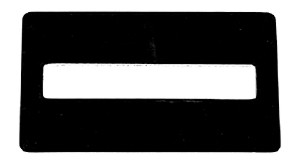Some people with low vision may have problems with handwriting. They may be unable to see the lines on which to write and/or may be unable to read back what they have written. These issues can generally be addressed by applying the 'Bigger, Bolder, Brighter' principles.
Handwriting using 'Bigger, Bolder, Brighter' principles
Use larger letters (bigger)
- Write your letters as large as you need in order to read them. Printing is easier to read than running writing and lowercase letters are generally easier to read than capital letters.
- A hand-held magnifier may help you read what you have written. Vision Australia staff can assist you choose the most suitable magnifier.
Use adequate lighting (brighter)
- Make the best use of available light (as discussed previously). A hand-held torch can also be helpful if you need more light.
- Make use of natural daylight, ensuring that you are not affected by glare (by sitting with your back to the window).
- Use an additional light such as a task lamp or wall-mounted light. To avoid glare, place the lamp behind or beside your shoulder, and below eye level and direct the light down onto the page.
Use contrast (bolder)
- Use as much contrast as you need, for example, black pen on white paper. Some people prefer a different colour contrast, such as yellow paper and black pen. Try some different combinations to find what is best for you.
- Most people find that a medium point felt tipped pen is the easiest type of pen to see.
- A contrasting place mat or darker piece of paper placed under the writing paper will make it easier to identify its edge.
- Contrast can also be achieved by putting the paper on a clipboard. This has the added advantage of holding the paper steady. Chose a matte coloured clipboard to minimise glare.
Keeping on or between the lines
There are a number of aids which can make writing easier by providing contrast and/or tactile guides. The main ones are signature guides, bold lined writing pads and writing frames. These are all available from Vision Australia.
Signature guide
This is a dark rectangular piece of plastic or cardboard about the size of a credit card, with a large slot cut into it (see diagram). When the card is placed on a page, you can feel for the space in which to sign your name, or you may be able to see the white paper showing through in contrast to the dark background of the guide.
The guide is placed so that the lower edge of the slot lies along the line where you are to sign.
The image below shows a signature guide that can be used to ensure you sign on the correct part of the page.

A similar, larger guide is available for addressing envelopes.
Bold lined writing pads
Writing pads with heavy black lines are available in A4 and notepad size.
These pads are useful for writing lists and letters for other people to read. They may not be useful for people with distorted vision, as the lines appear to waver.
Often people find that while the pads are useful for writing notes to other people, it is not easy to read back what they have written as the bold lines are too close together. In this case it may be better to use plain paper and a writing frame or letter guide.
Writing frames
Depending on the type of frame, paper is placed underneath or inside so that you can write between plastic slots or elastic strings.
Some other writing tips
- Avoid lifting your pen in the middle of a word so you don't lose your place.
- If you are writing notes to yourself, you could develop your own method of abbreviations or shorthand for commonly used words.
- Alternatives to handwriting include typing your information into a computer in larger print or doing an audio recording of your information.
Get more information and support
Read more about living independently. For more information on Vision Australia’s services call our helpline on 1300 84 74 66 or email info@visionaustralia.org. You can also connect with our services here.










